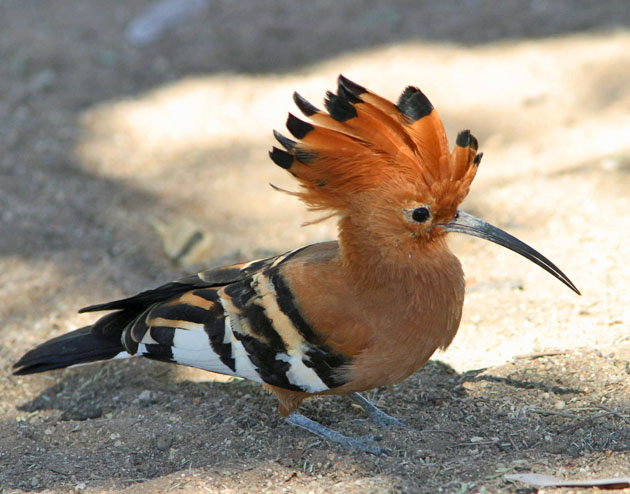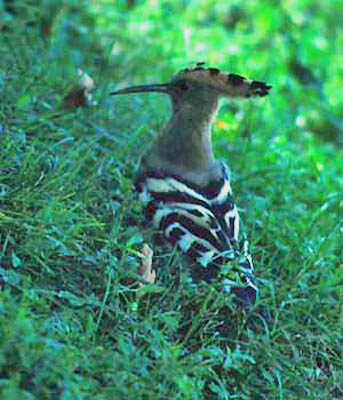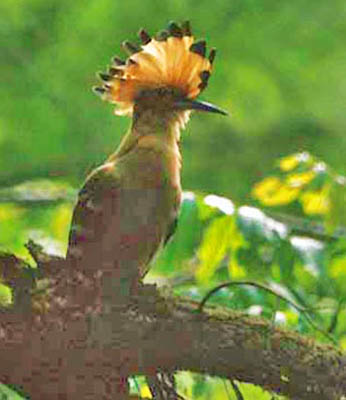| |
HOOPOES Upupidae |
- 3 species in Eurasia and Africa
- DR personal total: 3 species (100%), 3 photo'd
|
 The Upupidae is a small Old World family of comprised of one, two, or three closely-related species of Hoopoes. All have long, thin, and decurved bills; broad round wings; square tails crossed by a wide white band, and long erectile Chinese-fan crests. Hoopoes are open-country birds — birds of savanna and broken woodlands — and do not occur in dense jungle. There is no clear agreement on how many species there are. The Upupidae is a small Old World family of comprised of one, two, or three closely-related species of Hoopoes. All have long, thin, and decurved bills; broad round wings; square tails crossed by a wide white band, and long erectile Chinese-fan crests. Hoopoes are open-country birds — birds of savanna and broken woodlands — and do not occur in dense jungle. There is no clear agreement on how many species there are.
There is but one genus (Upupa) and up to 8 subspecies (and another extinct). There was dispute about the number of Hoopoe species when I created my first family page in 1999, and there remains dispute today at this update (2020). Handbook of Birds of the World (Kristín 2001) had one species; the current Clements/eBird list has two, and the current IOC checklist has three. Until there is better agreement, I'll adopt 3 species to be discussed. Under this arrangement, this is African Hoopoe (left and below), photos for Namibia and Tanzania, respectively. |
 |
 However many species there are, can anyone forget their first encounter with the absolutely outrageous Hoopoe? My first was a migrant in flight in Iran in August 1978, and my first photo was in Kashmir four days later (right). These were Eurasian Hoopoe, honored with one of the world's greatest scientific names — Upupa epops — that rolls eponymously across the tongue. OOH papa EE pops! There is also just something about a hoopoe. Perhaps it is because it is quite a rarity in England. It is annual there — averaging 125 per year in the period 1958-1967, and a few have remained to breed (Sharrock 1974) — but it still is quite a good find on one's local patch, and especially exciting because it looks so odd. I can no longer locate the reference, but someone has said that hoopoes had an affinity for vicar's gardens. This image has remained with me for many years. I rather like Witherby et al's (1943) description of the Hoopoe's behavior: However many species there are, can anyone forget their first encounter with the absolutely outrageous Hoopoe? My first was a migrant in flight in Iran in August 1978, and my first photo was in Kashmir four days later (right). These were Eurasian Hoopoe, honored with one of the world's greatest scientific names — Upupa epops — that rolls eponymously across the tongue. OOH papa EE pops! There is also just something about a hoopoe. Perhaps it is because it is quite a rarity in England. It is annual there — averaging 125 per year in the period 1958-1967, and a few have remained to breed (Sharrock 1974) — but it still is quite a good find on one's local patch, and especially exciting because it looks so odd. I can no longer locate the reference, but someone has said that hoopoes had an affinity for vicar's gardens. This image has remained with me for many years. I rather like Witherby et al's (1943) description of the Hoopoe's behavior:
"Feeds mainly on ground, walking with ease (and even running) with accompanying movement of head. Fond of feeding on lawns and path or, alternatively, on manure or refuse-heaps, probing for larvae, etc. Crest depressed when at rest, but erected when excited or alarmed and for a moment on settling. Flight is not weak and uncertain as it appears, for it will readily elude trained falcons, mounting easily into the air away from them. Perches in trees, as well as on buildings, walls, etc., and according to Lilford will occasionally climb up tree like a woodpecker, but this is not usual. Fond of dust and sand-baths."
And so there you have an image of the hoopoe, evading the trained falcons as it searches for a vicar's garden in which to take a dust bath before probing the refuse-heap . . .
The species is much rarer in the New World, with but a single specimen collected on 3 September 1975 at Old Chevak, Yukon-Kuskokwim Delta, Alaska (Dau & Paniyak 1977). This male added "a new species and family (Upupidae) to the avifauna of the Western Hemisphere," they write, but the bird had been discovered the day before as it "fed among drift logs and debris." No doubt near the shaman's garden. |
 Molecular evidence has shown that the hoopoes (Upupidae) and wood-hoopoes (Phoeniculidae) are sister taxa that are related to hornbills (Hackett et al. 2008). More recently, the hoopoes and hornbills were separate from the Coraciiformes at the Order level, and they now form the Order Bucerotiformes (Prum et al. 2015). Molecular evidence has shown that the hoopoes (Upupidae) and wood-hoopoes (Phoeniculidae) are sister taxa that are related to hornbills (Hackett et al. 2008). More recently, the hoopoes and hornbills were separate from the Coraciiformes at the Order level, and they now form the Order Bucerotiformes (Prum et al. 2015).
This Madagascar Hoopoe (left) has its crest erected, something that doesn't happen very often. Its plumage is a bit richer in color than continental forms, and it is bit larger, but at the species level, all major checklist now separate Madagascar Hoopoe from the continental forms because of distinctive vocalizations. Fry, Keith & Urban (1988) argued that while splitting African-breeding Hoopoes from Eurasian ones was problematic, "a much stronger case can be made for separating Madagascan birds specifically, their voices evidently being quite different." This is the position taken by most authorities on Madagascar (e.g., Morris & Hawkins 1998; current 2019 Clements checklist).
Those that split African population from Eurasian populations have pointed out that, as breeders, those populations are allopatric (e.g., Sibley & Monroe 1990). Some have even argued for four species of Hoopoe, with the subSaharan breeders in the Sahel the fourth group. Currently, those that have a 3-way split have the dividing line between Eurasian and African Hoopoes at about the equator, with Sahel and north Africa populations considered subspecies of Eurasian Hoopoe (e.g., IOC checklist). Behaviorally, the Eurasian and African birds are the same, plumage differences are minor, and most vocalizations are similar ((Kristín 2001). |
|  All hoopoes have dramatic black and white wing patterns — the exact patterns vary slightly between the species — that show in flight or (right) when the bird is preening (photo right of Madagascar Hoopoe). Behaviorally, hoopoes remind me, a New World resident, of American flickers, a type of woodpecker. Both hoopoes and flickers appear superficial to be birds of the trees but each spend most of their foraging time on the ground, probing the leaf-litter. All hoopoes have dramatic black and white wing patterns — the exact patterns vary slightly between the species — that show in flight or (right) when the bird is preening (photo right of Madagascar Hoopoe). Behaviorally, hoopoes remind me, a New World resident, of American flickers, a type of woodpecker. Both hoopoes and flickers appear superficial to be birds of the trees but each spend most of their foraging time on the ground, probing the leaf-litter.
In addition, both hoopoes and flickers nest in tree cavities. Baby hoopoes are covered with down at hatching, while other members of their Order have naked young. Another distinctive hoopoe character is that it has a tufted oil-gland which, in brooding females, produces an oil whose smell repeals intruders. |
| |
Photos: The first African Hoopoe Upupa africana was at Okaukuejo, Etosha NP, Namibia, on 18 July 2005, and the second in Tarangire NP, 9 June 2018. The Eurasian Hoopoe Upupa epops was at Srinigar, Kashmir, India, in Aug 1978. The Madagascar Hoopoe Upupa marginata was in the Ampijoroa Reserve, northwestern Madagascar, in Nov 1992.
All photos © Don Roberson; all rights reserved.
Bibliographic note: There is no "family book" per se, but a fine introduction to this family, with some excellent photos, is in Kristín (2001).
Literature cited:
Dau, C.P., and J. Paniyak. 1977. Hoopoe, a first record for North America. Auk 94: 601.
Fry, C.H., S. Keith, and E.K. Urban. 1988. The Birds of Africa. Vol. 3. Academic Press, London.
Hackett, S.J., R.T. Kimball, S. Reddy, R.C.K. Bowie, E.L. Braun, M.J. Braun, J.L. Chojnowski, W.A. Cox, K-L. Han, J. Harshman, C.J. Huddleston, B.D. Marks, K.J. Miglia, W.S. Moore, F.H. Sheldon, D.W. Steadman, C.C. Witt, and T. Yuri. 2008. A phylogenetic study of birds reveals their evolutionary history. Science 320: 1763–1767.
Kristín, A. 2001. Family Psophiidae (Trumpeters), pp. 396–411 in Handbook of the Birds of the World (del Hoyo, J., A. Elliott & J. Sargatal, eds). Vol. 3. Lynx Edicions, Barcelona, Spain.
Morris, P., and F. Hawkins. 1998. Birds of Madagascar: A Photographic Guide. Yale Univ. Press, New Haven, CT.
Prum, R.O., J.S. Berv, A. Dornburg, D.J. Field, J.P. Townsend, E.M. Lemmon, and A.R. Lemmon. 2015. A comprehensive phylogeny of birds (Aves) using targeted next-generation DNA sequencing. Nature 526: 569–573.
Sharrock, J.T.R. 1974. Scarce Migrant Birds in Britain and Ireland. T. & A.D. Poyser, Berkhamsted, U.K.
Sibley, C.G., and B.L. Monroe, Jr. 1990. Distribution and Taxonomy of Birds of the World. Yale Univ. Press, New Haven, CT.
Witherby, H.F., F.C.R. Jourdain, N.F. Ticehurst, and B.W. Tucker. 1943. The Handbook of British Birds. Rev. ed. Vol. 2: Warblers to Owls. H. F. & G. Witherby, Ltd., London.
|
|
|


 The Upupidae is a small Old World family of comprised of one, two, or three closely-related species of Hoopoes. All have long, thin, and decurved bills; broad round wings; square tails crossed by a wide white band, and long erectile Chinese-fan crests. Hoopoes are open-country birds — birds of savanna and broken woodlands — and do not occur in dense jungle. There is no clear agreement on how many species there are.
The Upupidae is a small Old World family of comprised of one, two, or three closely-related species of Hoopoes. All have long, thin, and decurved bills; broad round wings; square tails crossed by a wide white band, and long erectile Chinese-fan crests. Hoopoes are open-country birds — birds of savanna and broken woodlands — and do not occur in dense jungle. There is no clear agreement on how many species there are.  However many species there are, can anyone forget their first encounter with the absolutely outrageous Hoopoe? My first was a migrant in flight in Iran in August 1978, and my first photo was in Kashmir four days later (right). These were Eurasian Hoopoe, honored with one of the world's greatest scientific names — Upupa epops — that rolls eponymously across the tongue. OOH papa EE pops! There is also just something about a hoopoe. Perhaps it is because it is quite a rarity in England. It is annual there — averaging 125 per year in the period 1958-1967, and a few have remained to breed (Sharrock 1974) — but it still is quite a good find on one's local patch, and especially exciting because it looks so odd. I can no longer locate the reference, but someone has said that hoopoes had an affinity for vicar's gardens. This image has remained with me for many years. I rather like Witherby et al's (1943) description of the Hoopoe's behavior:
However many species there are, can anyone forget their first encounter with the absolutely outrageous Hoopoe? My first was a migrant in flight in Iran in August 1978, and my first photo was in Kashmir four days later (right). These were Eurasian Hoopoe, honored with one of the world's greatest scientific names — Upupa epops — that rolls eponymously across the tongue. OOH papa EE pops! There is also just something about a hoopoe. Perhaps it is because it is quite a rarity in England. It is annual there — averaging 125 per year in the period 1958-1967, and a few have remained to breed (Sharrock 1974) — but it still is quite a good find on one's local patch, and especially exciting because it looks so odd. I can no longer locate the reference, but someone has said that hoopoes had an affinity for vicar's gardens. This image has remained with me for many years. I rather like Witherby et al's (1943) description of the Hoopoe's behavior:  Molecular evidence has shown that the hoopoes (Upupidae) and wood-hoopoes (Phoeniculidae) are sister taxa that are related to hornbills (Hackett et al. 2008). More recently, the hoopoes and hornbills were separate from the Coraciiformes at the Order level, and they now form the Order Bucerotiformes (Prum et al. 2015).
Molecular evidence has shown that the hoopoes (Upupidae) and wood-hoopoes (Phoeniculidae) are sister taxa that are related to hornbills (Hackett et al. 2008). More recently, the hoopoes and hornbills were separate from the Coraciiformes at the Order level, and they now form the Order Bucerotiformes (Prum et al. 2015).  All hoopoes have dramatic black and white wing patterns — the exact patterns vary slightly between the species — that show in flight or (right) when the bird is preening (photo right of Madagascar Hoopoe). Behaviorally, hoopoes remind me, a New World resident, of American flickers, a type of woodpecker. Both hoopoes and flickers appear superficial to be birds of the trees but each spend most of their foraging time on the ground, probing the leaf-litter.
All hoopoes have dramatic black and white wing patterns — the exact patterns vary slightly between the species — that show in flight or (right) when the bird is preening (photo right of Madagascar Hoopoe). Behaviorally, hoopoes remind me, a New World resident, of American flickers, a type of woodpecker. Both hoopoes and flickers appear superficial to be birds of the trees but each spend most of their foraging time on the ground, probing the leaf-litter.